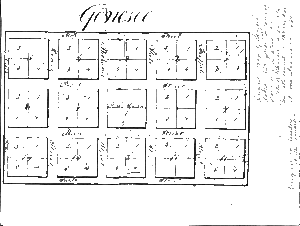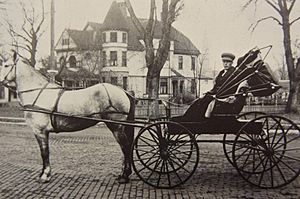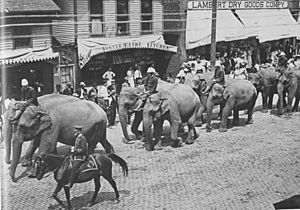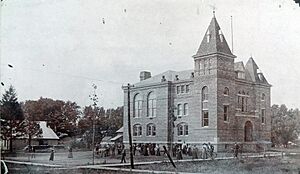Geneseo, Illinois facts for kids
Quick facts for kids
Geneseo
|
|
|---|---|
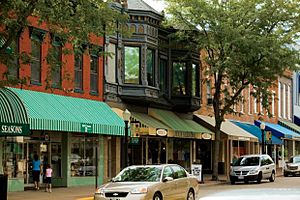
Downtown Geneseo, Illinois
|
|
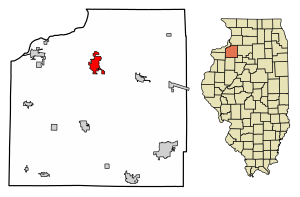
Location of Geneseo in Henry County, Illinois.
|
|

Location of Illinois in the United States
|
|
| Country | United States |
| State | Illinois |
| County | Henry |
| Founded | 1836 |
| Area | |
| • Total | 4.70 sq mi (12.18 km2) |
| • Land | 4.70 sq mi (12.18 km2) |
| • Water | 0.00 sq mi (0.00 km2) |
| Population
(2020)
|
|
| • Total | 6,539 |
| • Density | 1,390.98/sq mi (537.03/km2) |
| Time zone | UTC-6 (CST) |
| • Summer (DST) | UTC-5 (CDT) |
| ZIP Code(s) |
61254
|
| Area code(s) | 309 |
| FIPS code | 17-28846 |
| Wikimedia Commons | Geneseo, Illinois |
Geneseo is a city in Henry County, Illinois, United States. In 2020, about 6,539 people lived there. Geneseo is located 20 miles east of the Quad Cities. It sits where Interstate 80, U.S. Route 6, and Illinois Route 82 meet. The city is famous for its successful high school sports and music programs, and its beautiful Victorian architecture.
Contents
History of Geneseo
Geneseo was started in 1836 by seven Christian families. They were part of the Congregationalist church and came from towns in New York called Geneseo, New York and Bergen, New York. They wanted to create a new community, a "church in the wilderness." One of the founders, Roderick R. Stewart, named the town Geneseo. This name comes from an Iroquois word, Genesee, which means "shining valley" or "beautiful valley."
How Geneseo Was Started
People started planning for this new community as early as 1829. In May 1836, the seven founding families sent a group to find the perfect spot in the Old Northwest. This group, called the "New York Committee," included John C. Ward, Lukas T. Seyller, and Roderick R. Stewart. They got advice in Chicago from Thomas Ford, who later became the Governor of Illinois. The committee then rode by wagon and horseback to explore a large area of land. They bought 2,000 acres for about a dollar and a quarter per acre in what is now Colona Township.
On September 17, 1836, the settlers began their long trip from Geneseo, New York and Genesee County, New York. They traveled through Canada, Michigan, Indiana, and finally into Illinois. The first winter was very harsh, so the families stayed in Princeton, Illinois while their new homes were being built. Cromwell K. Bartlett built the first structure just south of town in the winter of 1836. Elisha Cone and J.C. Ward built the first cabin and frame house in town in 1837.
The town's leaders, John C. Ward, Cromwell K. Bartlett, and R.R. Stewart, divided the land into lots. They set aside areas for a cemetery, a school, a church, a public square, and a "gospel lot." This "gospel lot" later became a seminary in 1846. Settlers chose their lots by chance, and the town quickly focused on Christian values and education. They even set up a rule that a part of all earnings (over a certain amount) would go towards building a religious and educational seminary. This building, first called the Geneseo Manual Labor High School, then the Geneseo Seminary, is now the Geneseo City Park. It closed in 1857 due to debt and became part of the public school system as Geneseo Central School.
The settlers also showed their strong beliefs by starting a temperance society in 1836. This was even before many families had arrived and while others were battling frostbite. Construction on the first Congregationalist Church began in 1837, and its first communion was held in 1838. This church was very important to the community for its first 100 years.
These strong religious beliefs also made the town very active in politics. Geneseo residents were strong abolitionists (people who wanted to end slavery) and Republicans. Because of this, Geneseo became a stop on the Underground Railroad, a secret network that helped enslaved people escape to freedom.
Even before the church was built, the first school started in 1837. R.R. Stewart's daughter, Susannah Stewart, taught classes in a one-room schoolhouse. It was built using simple materials like puncheon floors and old wagon covers from their journey.
Growing the Town
In 1850, a railroad line, the Chicago, Rock Island, and Pacific Railroad (also known as the Rock Island Line), was planned to run from Chicago to Rock Island, with a major stop in Geneseo. The railroad was finished in June 1854. Soon after, a special promotional trip called the Grand Excursion brought important politicians and wealthy citizens to the small town. Geneseo had grown slowly, reaching only 500 people by 1850. But after the railroad arrived, its population quickly grew to 5,500 in just 11 years! Because of this fast growth, Geneseo officially became a town in 1855 and a city in 1865. Many wealthy families built their homes in the Victorian Architecture style during this time, and many of these beautiful homes still stand today, giving Geneseo the nickname "Victorian Geneseo."
Around the same time, Geneseo got its first newspaper, the Geneseo Democratic Standard, in August 1855. It closed down less than two years later. In June 1856, I.S. Hyatt started the Geneseo Republic. It began as a newspaper for the Republican Party but is now independent. It is still published today and is the only newspaper focused only on Geneseo.
Geneseo Central School, the first high school, was built in 1856. It joined with Geneseo Seminary in 1857. This building was used until 1866 when the North Side Building was constructed. The North Side Building was expanded in 1871 and torn down in 1970. South Side School, built in 1889, became the official high school for Geneseo in 1890.
In 1883, two colleges were started in Geneseo: the Geneseo Collegiate Institute (GCI) and the Northwestern Normal School (NNS). GCI was a Presbyterian school that also had a small religious high school for a while. Even though a big expansion was planned for GCI in the early 1900s, the school ran out of money in 1922 and was torn down in 1930. The Northwestern Normal School was a non-religious college. It also faced financial problems. In 1901, John C. Hammond bought NNS's old dorm building and gave it to the City of Geneseo to start Hammond Henry Hospital on November 28, 1901.
Schools in the 20th Century
In 1909, the Township High School District was created. The Township High School building was built between 1910 and 1911 and was greatly expanded in 1932. The old South Side School was then used for younger students (kindergarten to 8th grade) until a new junior high school was built in 1954. South Side School later became an office building until the 1960s when it was torn down for a new district office. In the 1960s, Geneseo High School and Geneseo Junior High switched buildings. The high school became J.D. Darnall Senior High School (but went back to Geneseo High School in 2005). The old "Township High School" building was then used as Geneseo Junior High School until the 1990s. That's when Geneseo Middle School was built next to J.D. Darnall. The old Township High building was then torn down to make more space for the city park.
Geography
Geneseo covers about 4.70 square miles (12.18 square kilometers) of land.
Climate
| Climate data for Geneseo, Illinois (1991–2020 normals, extremes 1895–present) | |||||||||||||
|---|---|---|---|---|---|---|---|---|---|---|---|---|---|
| Month | Jan | Feb | Mar | Apr | May | Jun | Jul | Aug | Sep | Oct | Nov | Dec | Year |
| Record high °F (°C) | 66 (19) |
72 (22) |
89 (32) |
92 (33) |
99 (37) |
101 (38) |
107 (42) |
103 (39) |
99 (37) |
92 (33) |
79 (26) |
70 (21) |
107 (42) |
| Mean daily maximum °F (°C) | 30.8 (−0.7) |
35.7 (2.1) |
48.9 (9.4) |
62.2 (16.8) |
73.7 (23.2) |
82.0 (27.8) |
85.7 (29.8) |
83.4 (28.6) |
77.1 (25.1) |
64.0 (17.8) |
48.8 (9.3) |
35.9 (2.2) |
60.8 (16.0) |
| Daily mean °F (°C) | 22.7 (−5.2) |
27.2 (−2.7) |
39.1 (3.9) |
51.1 (10.6) |
62.6 (17.0) |
72.2 (22.3) |
75.4 (24.1) |
73.1 (22.8) |
65.8 (18.8) |
53.4 (11.9) |
39.8 (4.3) |
28.2 (−2.1) |
50.9 (10.5) |
| Mean daily minimum °F (°C) | 14.6 (−9.7) |
18.6 (−7.4) |
29.3 (−1.5) |
39.9 (4.4) |
51.6 (10.9) |
61.5 (16.4) |
65.1 (18.4) |
62.9 (17.2) |
54.5 (12.5) |
42.9 (6.1) |
30.7 (−0.7) |
20.5 (−6.4) |
41.0 (5.0) |
| Record low °F (°C) | −25 (−32) |
−25 (−32) |
−13 (−25) |
12 (−11) |
26 (−3) |
37 (3) |
44 (7) |
40 (4) |
24 (−4) |
19 (−7) |
−7 (−22) |
−20 (−29) |
−25 (−32) |
| Average precipitation inches (mm) | 1.64 (42) |
1.81 (46) |
2.70 (69) |
3.96 (101) |
4.87 (124) |
4.42 (112) |
4.13 (105) |
4.10 (104) |
3.57 (91) |
3.21 (82) |
2.56 (65) |
2.12 (54) |
39.09 (993) |
| Average snowfall inches (cm) | 9.8 (25) |
6.1 (15) |
2.8 (7.1) |
0.7 (1.8) |
0.0 (0.0) |
0.0 (0.0) |
0.0 (0.0) |
0.0 (0.0) |
0.0 (0.0) |
0.1 (0.25) |
1.6 (4.1) |
7.3 (19) |
28.4 (72) |
| Average precipitation days (≥ 0.01 in) | 8.4 | 7.2 | 9.3 | 10.6 | 12.0 | 10.2 | 8.1 | 9.0 | 7.7 | 8.6 | 8.2 | 8.3 | 107.6 |
| Average snowy days (≥ 0.1 in) | 4.7 | 3.1 | 1.4 | 0.3 | 0.0 | 0.0 | 0.0 | 0.0 | 0.0 | 0.1 | 0.8 | 3.5 | 13.9 |
| Source: NOAA | |||||||||||||
People of Geneseo (Demographics)
| Historical population | |||
|---|---|---|---|
| Census | Pop. | %± | |
| 1860 | 1,794 | — | |
| 1870 | 3,042 | 69.6% | |
| 1880 | 3,518 | 15.6% | |
| 1890 | 3,182 | −9.6% | |
| 1900 | 3,356 | 5.5% | |
| 1910 | 3,199 | −4.7% | |
| 1920 | 3,375 | 5.5% | |
| 1930 | 3,406 | 0.9% | |
| 1940 | 3,824 | 12.3% | |
| 1950 | 4,325 | 13.1% | |
| 1960 | 5,169 | 19.5% | |
| 1970 | 5,538 | 7.1% | |
| 1980 | 5,780 | 4.4% | |
| 1990 | 5,995 | 3.7% | |
| 2000 | 6,480 | 8.1% | |
| 2010 | 6,586 | 1.6% | |
| 2020 | 6,539 | −0.7% | |
| U.S. Decennial Census | |||
In 2020, Geneseo had 6,539 people living in 2,903 households. Most people (about 92.5%) were White. About 3.2% of the population was Hispanic or Latino.
About 22.9% of the people in Geneseo were under 18 years old. About 27.3% were 65 years or older. The average age in the city was 47.1 years.
Economy
Geneseo is home to Springfield Armory, Inc., a company that makes guns.
Culture and Events
Geneseo hosts several fun events each year. These include the Geneseo Music Festival, which happens on Father's Day weekend. Another popular event is the Geneseo Christmas Walk, held on the second Saturday of December. It used to be called the Geneseo Victorian Walk.
Infrastructure
The downtown area of Geneseo will become a stop on the new Amtrak train line that goes from Chicago to Des Moines.
Education
Geneseo's schools are part of Dist. 228. This district includes Geneseo High School (GHS). In 2023, U.S. News & World Report recognized Geneseo High School as one of the best high schools in the country. In its region, GHS was ranked second in the Quad Cities Area and 93rd in Illinois.
The Geneseo High School football team, known as the "Green Machine," has been very successful. They have won 4 state championships and finished second in the state 6 times. They also have an amazing record of 54 winning seasons in a row and more than 40 consecutive playoff appearances, which is an Illinois state record!
The Geneseo High School Music Department has also achieved great success. They have won 6 State Championships, finished second in the state 10 times, and placed third 6 times in music competitions.
Notable people
- Earnest Elmo Calkins, an important person in advertising
- Agnes Meyer Driscoll, a cryptanalyst (someone who studies codes)
- William O. "Doc" Farber, a famous American Political Scientist
- Judith Ford, Miss America in 1969
- Edith Dunham Foster, a filmmaker who made educational movies
- Barry Pearson, an NFL wide receiver for the Pittsburgh Steelers and Kansas City Chiefs
- Leon Alaric Shafer, a painter and illustrator
- Todd Sieben, an Illinois State Senator
- Jack Wanner, an MLB shortstop for the New York Highlanders
- Butch Patrick, an actor famous for playing Eddie Munster, lived in Geneseo as a child.
See also
 In Spanish: Geneseo (Illinois) para niños
In Spanish: Geneseo (Illinois) para niños


